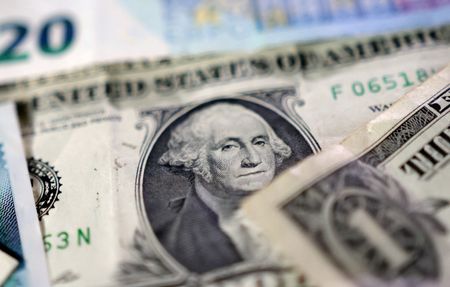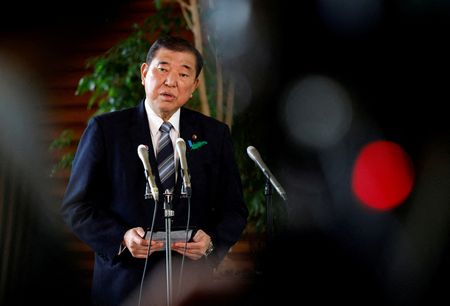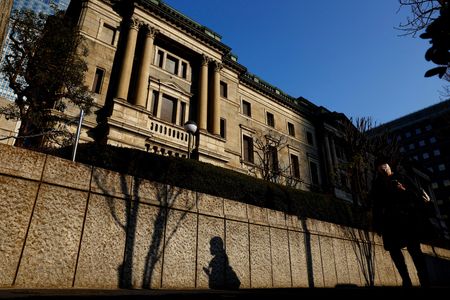By Rocky Swift and Kevin Buckland
TOKYO (Reuters) -The U.S. dollar dipped to a one-week low versus the safe-haven yen on Monday as markets digested a surprise downgrade of the U.S. government’s credit rating and as trade friction concerns weighed on sentiment.
Australia’s dollar turned higher following three days of declines ahead of Tuesday’s Reserve Bank of Australia policy announcement, with a quarter-point cut widely expected.
Moody’s cut the United States’ top sovereign credit rating by one notch on Friday, the last of the major ratings agencies to downgrade the country, citing concerns about its growing $36 trillion debt pile.
The news saw the dollar turn lower against its major rivals following four straight winning weeks when it was boosted by rising optimism for U.S. trade deals and then a thaw in relations with China that eased fears of a global recession.
The greenback slipped as much as 0.6% to 144.80 yen for the first time since May 9 on Monday, while the euro gained as much as 0.3% to $1.1199.
“While the decision itself is seen as a catch-up to S&P’s move on 5 August 2011 and Fitch’s announcement to do the same on 1 August 2023, Moody’s decision could still feed USD bears,” said Paul Mackel, global head of FX research at HSBC.
“Given this rating erosion has been slow moving, the simple takeaway is Moody’s step should not matter for the USD. But one needs to be careful with this assumption.”
U.S. Treasury Secretary Scott Bessent said in television interviews on Sunday that President Donald Trump will impose tariffs at the rate he threatened last month on trading partners that do not negotiate in “good faith.”
However, a Financial Times report that the United States had begun serious trade talks with the European Union, breaking a long deadlock, offered some hope for additional deals after Washington inked a framework agreement with Britain earlier this month.
Trump has previously said he has potential deals with India, Japan and South Korea as well, although talks with Tokyo seem to be stumbling over car tariffs.
In the market, “there’s a lot of complacency about the ability to pull off deals,” said Ray Attrill, head of FX strategy at National Australia Bank.
“Confidence that the U.S. economy is going to weather this is very much open to question.”
Trump cleared a hurdle towards passing a sweeping tax cut bill that would add an estimated $3 trillion to $5 trillion to the nation’s debt over the next decade, after winning approval from a key congressional committee.
The dollar declined 0.2% to 0.8358 Swiss franc, another safe-haven currency. Sterling added 0.1% to $1.3297.
“The focus on U.S. growth risks and the U.S. administration’s policy agenda may have put the U.S. safe-haven status in question,” said Mahjabeen Zaman, head of foreign exchange research at ANZ.
The Australian dollar edged up 0.1% to $0.6413 after sliding more than 1% over the prior three sessions.
Markets have priced in a certainty of a quarter-point cut to the RBA’s 4.10% cash rate on Tuesday, as slowing inflation allows policymakers to respond to rising global risks.
The central bank’s guidance will be key, as investors have reduced their expectations for rapid-fire rate cuts in the coming months following the Sino-U.S. tariff truce and robust Australian employment data.
New Zealand’s kiwi dollar rose 0.2% to $0.5890.
Bitcoin briefly jumped as much as 2.8% to reach $107,060.46 for the first time since January, the same month that the token notched its all-time peak of $109,071.86.
(Reporting by Rocky Swift and Kevin Buckland; Editing by Stephen Coates and Edwina Gibbs)










